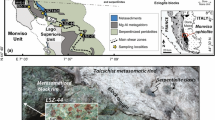Abstract
The subduction of hydrated oceanic lithosphere potentially transports large volumes of water into the upper mantle; however, despite its potential importance, fluid–rock interaction during high-pressure metamorphism is relatively poorly understood. The stable isotope and major element geochemistry of Pennine ophiolite rocks from Italy and Switzerland that were metamorphosed at high pressures are similar to that of unmetamorphosed ophiolites, suggesting that they interacted with little pervasive fluid during high-pressure metamorphism. Cover sediments also have oxygen isotope ratios within the expected range of their protoliths. In the rocks that escaped late greenschist-facies retrogression, different styles of sub-ocean-floor alteration may be identified using oxygen isotopes, petrology, and major or trace element geochemistry. Within the basalts, zones that have undergone high- and low-temperature sub-ocean-floor alteration as well as relatively unaltered rocks can be distinguished. Serpentinites have δ18O and δ2H values that suggest that they were formed by hydration on or below the ocean floor. The development of high-pressure metamorphic mineralogies in metagabbros occurred preferentially in zones that underwent sub-ocean-floor alteration and which contained hydrated, fine-grained, reactive assemblages. Given that the transformation of blueschist-facies metabasic rocks to eclogite-facies assemblages involves the breakdown of hydrous minerals (e.g. lawsonite, zoisite, and glaucophane), and will thus liberate considerable volumes of fluids, metamorphic fluid flow must have been strongly channelled. High-pressure (quartz+calcite±omphacite±glaucophane±titanoclinohumite) veins that cut the ophiolite rocks represent one possible channel; however, stable isotope and major element data suggest that they were not formed from large volumes of exotic fluids. Fluids were more likely channelled along faults and shear zones that were active during high-pressure metamorphism. Such strong fluid channelling may cause fluids to migrate toward the accretionary wedge, especially along the slab–mantle interface, which is probably a major shear zone. This may preclude all but a small fraction of the fluids entering the mantle wedge to flux melting. Additionally, because fluids probably interact with relatively small volumes of rock in the channels, they cannot "scavenge" elements from the subducting slab efficiently.
Similar content being viewed by others
Author information
Authors and Affiliations
Additional information
Received: 28 January 1999 / Accepted: 2 February 1999
Rights and permissions
About this article
Cite this article
Cartwright, I., Barnicoat, A. Stable isotope geochemistry of Alpine ophiolites: a window to ocean-floor hydrothermal alteration and constraints on fluid–rock interaction during high-pressure metamorphism. Int Journ Earth Sciences 88, 219–235 (1999). https://doi.org/10.1007/s005310050261
Issue Date:
DOI: https://doi.org/10.1007/s005310050261




